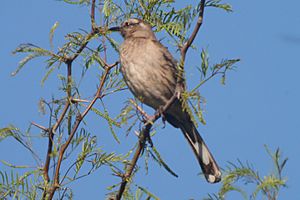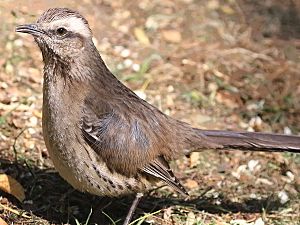Chilean mockingbird facts for kids
Quick facts for kids Tenca, Chilean mockingbird |
|
|---|---|
 |
|
| Conservation status | |
| Scientific classification | |
| Genus: |
Mimus
|
| Species: |
thenca
|
 |
|
The Chilean mockingbird (Mimus thenca) is a special type of bird. People in Chile often call it tenca. This bird belongs to the Mimidae family, which includes other mockingbirds. You can mostly find it in the northern part of Chile. Sometimes, it is also seen in Argentina.
Contents
What Does the Chilean Mockingbird Look Like?

The Chilean mockingbird is about 28 to 29 cm (11 to 11 in) long. That's about the length of a ruler! It weighs around 66 g (2.3 oz). Male birds are usually a bit bigger than females.
These birds have a wide, whitish stripe above their eyes, like an eyebrow. Their head, neck, and back are brownish-gray with darker stripes. Their lower back is a browner color. Their wings and tail are blackish. When their wings are folded, you can see two thin bars on them. The outer tail feathers have white edges, and most other tail feathers have white tips.
Their throat is whitish, and their chest is brownish-gray. Their belly is a dirty white, and their sides are buffy with blackish streaks. Young birds look similar but have more buffy colors and streaks on their underside.
Where Do Chilean Mockingbirds Live?
The Chilean mockingbird lives in Chile, from the Copiapó Province in the north down to Los Lagos, Puerto Montt, and Chiloé Island in the south. A small group of these birds also lives in Neuquén Province, Argentina.
These birds can live in many different places. They like areas with scrub, bushes, or trees that are spread out. This includes coastal areas with special plants, grassy plains with bushes, and evergreen Chilean matorral (a type of shrubland). They also live at the edges of small patches of old forests, like those in Bosque de Fray Jorge National Park. You might even see them in areas changed by people, but they rarely live in big cities.
They do not like forests with Nothofagus or Cryptocarya trees in the south. They also avoid pine tree farms in central Chile. You can find them from sea level all the way up to 2,200 m (7,200 ft) high in the mountains.
How Do Chilean Mockingbirds Behave?
What Do They Eat?
Chilean mockingbirds mostly look for food on the ground. They turn over leaves and dig under fallen branches and around plant stems. They also hunt for food in plants up to 3 m (9.8 ft) above the ground.
They eat many different things, so they are called omnivores. They have been seen eating insects, wild fruits, fruits from farms, nectar (sweet liquid from flowers), and even small lizards!
How Do They Raise Their Young?
Chilean mockingbirds usually build their nests in October and November. They protect their territory, probably all year long. Their nest is shaped like a cup and is made of twigs lined with moss or soft wool. They place their nests low in plants like cacti and thorny bushes.
A female bird usually lays two to four eggs. Sometimes, another bird called a shiny cowbird (Molothrus bonariensis) will lay its eggs in the mockingbird's nest. This is called nest parasitism.
What Do They Sound Like?
The Chilean mockingbird sings all year round. Their song is a mix of sweet, changing notes and phrases. They are also known as "excellent mimics" because they can copy the songs of many other bird species!
Is the Chilean Mockingbird in Danger?
The IUCN (International Union for Conservation of Nature) has looked at the Chilean mockingbird. They have decided that this bird is of "Least Concern." This means that even though it lives in a somewhat small area, it is very common there. There are no known big threats to its population, so it is not in danger of disappearing.
See also
 In Spanish: Mimus thenca para niños
In Spanish: Mimus thenca para niños


